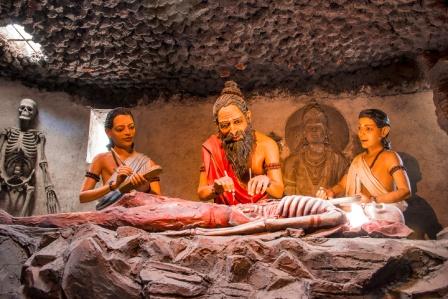Clue For Methodology Of Learning In Ayurvedic Treatises
By Dr Raghuram Y.S. MD (Ay) & Dr Manasa, B.A.M.S
The humankind has evolved through a process of constant learning. Every successive generation adds to this process and makes sure that the learning process doesn’t remain stagnant. The foundation of methodology of learning lay in the lessons given to us by our ancestors.
There are many means of learning. The sense organs have always been the tools of learning. The eyes are said to be the best among the sense organs. This is because we have primarily evolved as visual learners. Next is the ears. The other sense organs i.e. nose, skin and tongue are not far away. The integrated network of these organs of sense along with the mind, intelligence and soul complete the loop of components participating in perceiving the objects, getting their knowledge and understanding them.
Read – Importance Of Soul In Perception Of Knowledge: Atma Jnana

Ayurveda not only deals with prevention and cure of diseases but also teaches us the ethics and basics of living a healthy and moral life. It teaches us the motive and values of life while adjusting and tuning ourselves to every day, every season, the society around us and lot more. These secrets of healthy living have been documented in an orderly way for the benefit of mankind from time immemorial, in the form of various treatises.
Among these treatises, the Brihat Trayees or the greater trio are said to be the best texts of references. They are
- ‘Charaka Samhita’ – written by master Charaka
- ‘Sushruta Samhita’ – written by master Sushruta
- ‘Ashtanga Hridaya / Ashtanga Sangraha’ – written by master Vagbhata
Be it coincidence or fact, the names of the authors, just like the treatises they have written, also depict and the methodology of learning.
Read – Brihat Trayi: The 3 Treatises That Form The Foundation of Ayurveda
Charaka – Sushruta – Vagbhata – three-way clues for methodology of comprehensive learning
For a comprehensive learning, we should become Charaka, Sushruta and Vagbhata in that order. Let us now try to understand this concept.
Table of Contents
1. Become a Charaka
The name ‘Chara’ka has the term ‘chara’ in it. It means to wander.
Ancient man was a wanderer, a nomad. Before the concept of ‘settlements’, the ancient man either alone or with his troops used to wander from place to place in search of food, shelter and protection. While doing so, he used to explore and learn about lot of things. So, wandering became a source of learning. With evolution, man invented fire, wheel and many more things. He tamed animals, ploughed lands, made agriculture, invented jobs at this own place and created his own ways of living. Then he had to sell things and make trade. He created means of commuting like carts, carriages, ships and boats to travel. Again he was dependent on wandering, learnt a lot about life in distant lands and the inhabitants therein, and made relationships with people away from his place for trade and commerce. This way he explored many places, learnt new things and implemented new ways of living in his own land after coming back. This contributed to evolution of mankind. In the process he even discovered new lands.Thus, in the early part of evolution, man was primarily a visual learner.
Read – Acharya Charaka – Work, Samhita, Legacy, Chapters, Description
Chara, thus means to explore things by going around, by being a traveler. Aren’t we doing the same today? Yes, we are travelling to schools and colleges, to institutions of learning, be it in our locality or distant places of learning. We travel and attend seminars, symposiums etc to learn more things and update ourselves. Going to libraries for references are also included. Learning is still a process connected to traveling and commuting, wherein we move around to seek knowledge from relevant sources of learning.
The term chara also includes ‘being a traveler by mind and senses, learning through visualization’. In the modern day, we can travel to any information site, website or research papers, Google them; reach groups like WhatsApp and facebook wherein interesting discussions on important topics are taking place on daily basis to tap new information of learning. This, with the help of modern day advancements and sophisticated gadgets and apps, we are able to do wherever we are, even without travelling, just by having a phone or system connected to internet. This is also a form of traveling through internet. We have confined ourselves and changed the definition of ‘chara’. But it is equally important that we use the technologies as learning tools.
So, the first step of comprehensive learning is to ‘see and observe things.’ We need to travel a lot to achieve that, travel around, away and within us. Traveling within us helps us in spiritual learning.
Learning through chara not only feeds us the knowledge through visual learning, but also gives us knowledge related to other senses also.
Read – Relation Between Doshas, Sense Organs And Perception

2. Become a Sushruta
The name Su’shruta’ has the term ‘shruta’ in it. It means ‘to hear’ or ‘have patience hearing’.
This is the next important aspect of comprehensive hearing. One need to have an attitude of ‘patient hearing’ to perceive, understand, analyze and learn things. This is a sort of one way traffic wherein you should be open and humble enough to allow the flow of knowledge from its source of origin inside you. It needs a practice and humbleness to do it. The doubts may be clarified and queries may be put in after the other person has spoken, especially if the person is an expert or a resource person for the topic in conversation.
To obtain knowledge and learn from sruta sources you need not travel, but even when you are traveling distances in the phase of chara, to learn things, you will also learn through hearing. Learning through seeing and hearing are many times interrelated.
Read – Acharya Sushruta: Work, Samhita, Legacy, Amazing Facts
3. Become a Vagbhata
The name ‘Vag’bhata has the term ‘vag’ in it. It means ‘to speak’ or ‘express things’. This, according to me should come third in the chronology of methodology of learning. The license to speak comes only after thoroughly understanding any subject.
This can be achieved only by –
- visual learning acquired by observing through exploring and travelling i.e. chara and
- knowledge achieved through patient hearing i.e. shruta
This probably denotes the mechanism of recollection and reproduction of learnt and saved information from previous sources. This also becomes the basis of ‘memory’. It is only when you see and hear things properly that you can save the information inside you. In later time, when you are in a position to tell and discuss about any topic that you have learnt, you may recollect the information obtained by chara / drushta and shruta sources saved in your mind and subconscious files in the form of memory.
Read – Acharya Vagbhata: Work, Text Books, Legacy, Amazing Facts
The ‘Vak’ factor i.e. liberty to speak in the process of learning comes operation precisely after specialization in a subject. This will enable our words to find authenticity, courage and confidence as we speak.

‘Recollecting things which have been seen, heard or experienced is called as memory’.
Things which are learnt through seeing, hearing and experiencing are all achieved by moving around, i.e. chara – by being a Charaka. Things learnt through patient hearing are achieved by patient hearing alone. Things learnt through experiences are achieved through seeing, hearing and speaking. Therefore the names of these masters also include the process of memory alongside the methodology of learning.
Thus, we need to learn through exploring and observations, patient hearing and absorbing the information and knowledge. Following this process, we gradually graduate to speak with more authenticity once we have precise knowledge or expertise gained from previous experiences. In all these patience, commitment and dedication is the key.
Click to Consult Dr Raghuram Y.S. MD (Ayu) – Skype









